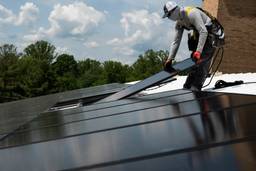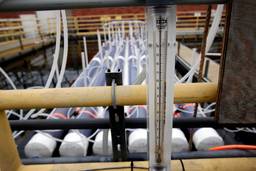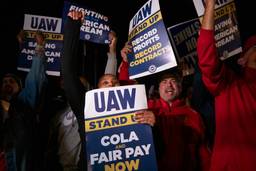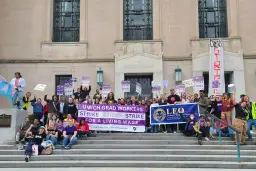8 Unions Have a Plan for Climate Action—But It Doesn’t Mention Fighting the Fossil Fuel Industry
Rachel M. Cohen
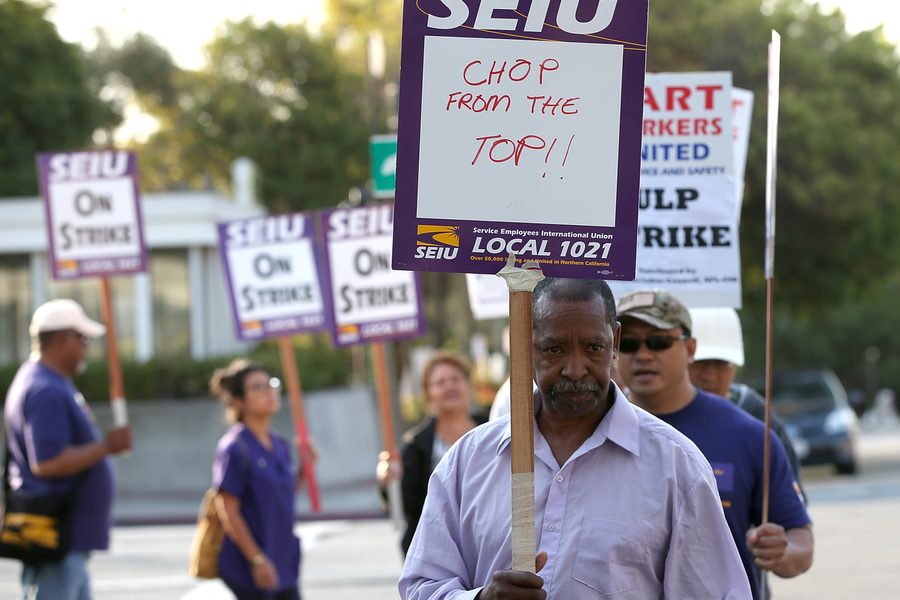
On June 24, the BlueGreen Alliance — a national coalition which includes eight large labor unions and six influential environmental groups—released an eight-page document laying out its vision to curb climate change and reduce inequality. The report, dubbed Solidarity for Climate Action, marks a significant development in the world of environmental politics. It argues the needs of working people must be front-and-center as the U.S. responds to climate change, and rejects the “false choice” between economic security and a healthy planet.
While the report’s focus on public investment, good jobs and justice shares much in common with the federal Green New Deal resolution introduced in February, it also stands in tension with environmentalists who demand the U.S. work to transition more quickly away from oil, coal and natural gas. “We’d really like them to be stronger and more concise about what it means to move away from fossil fuels and transition to renewables,” said José Bravo, executive director of the Just Transition Alliance and speaking on behalf of the Climate Justice Alliance. Members of the BlueGreen Alliance say the ultimate goal should be to decarbonize the economy — to reduce CO2 emissions, but not necessarily end the fossil fuel industry itself, with its tens of thousands of high-paying jobs. Other climate groups say that won’t be enough, and humanity cannot afford to preserve industries that have caused so much environmental harm. This difference in vision will stand as one of the most fundamental political questions facing progressives in the next decade.
The report spells out a series of principles, including limiting warming to 1.5°C, expanding union jobs, modernizing infrastructure, bolstering environmental protections and rebuilding the nation’s manufacturing sector with green technologies. It also elevates the issue of equity, calling to “inject justice into our nation’s economy by ensuring that economic and environmental benefits of climate change solutions support the hardest hit workers and communities.” The BlueGreen Alliance emphasizes the disproportionate impact low-income workers and communities of color will face, and says those affected by the energy transition must receive “a just and viable transition” to new, high-quality union jobs.
To make its platform a reality, the BlueGreen Alliance endorses a host of specific policies and timetables, like reaching net-zero emissions by 2050, while being “solidly on a path” to that goal by 2030. Among other things, the report calls for measures like restoring forests and wildlands, cracking down on employee misclassification, making it easier to unionize one’s workplace, winning universal access to high-speed Internet, and “massive” economic investing in deindustrialized areas, “including remediating any immediate loss of tax base or public services for communities.”
Labor groups in the coalition include the United Steelworkers, the Utility Workers Union of America, the Service Employees International Union, the American Federation of Teachers, the Communications Workers of America, the United Association of Plumbers and Pipefitters, the Union of Bricklayers and Allied Craftworkers, and the International Association of Sheet Metal, Air, Rail, and Transportation Workers. The environmental organizations include the Sierra Club, the Natural Resources Defense Council, the National Wildlife Federation, the Union of Concerned Scientists, the Environmental Defense Action Fund, and the League of Conservation Voters.
Following the 2016 election, the coalition organized listening sessions with workers in communities that voted for Donald Trump, like in Macomb County, Michigan, and the Iron Range in Wisconsin. After those discussions, leaders started investing in broader polling, message-testing and focus groups. While opponents of regulating greenhouse gas emissions relish exploiting tensions between environmentalists and labor unions, Mike Williams, the deputy director of the BlueGreen Alliance, said it became clear from the research “that working people do quite care about climate change, but they also believe they should not be forced to make a choice between that and having a good job.”
“We went through a lot of iterations and a lot of conversations,” said Sara Chieffo, the vice president of government affairs for the League of Conservation Voters. “There was real unanimity that we were solving the twin crises of inequality and climate change.”
Jeremy Brecher, the co-founder of the Labor Network for Sustainability, which supports organized labor in tackling climate change, tells In These Times that he sees the Solidarity for Climate Action report as “quite a significant stepping out” for the BlueGreen Alliance. “The BGA was basically [created in 2006] to advocate for the growth and quality of jobs in the clean economy,” he said. “It did not take positions on targets and timetables for carbon reduction, clean coal and the KXL pipeline. It was a green jobs organization, which is important in terms of understanding where the BGA was coming from.” Brecher says the BlueGreen Alliance’s new statement “about the pace of greenhouse gas emission reductions and the absolute centrality and necessity of it is an extremely positive development.”
Evan Weber, the political director and co-founder of the Sunrise Movement, agrees. “I think the platform represents a really historic step forward for a number of the nation’s largest and most influential labor unions,” he said. “It leaves some questions about what needs to be done, and we’d like to see more ambition, but it is really meaningful that these groups and unions have come to the table and shown that they’re willing to move forward and not stay in the ways of the past.”
The Green New Deal resolution was introduced in Congress as the BlueGreen Alliance hashed out its own proposal. The leaders of some labor unions in the BlueGreen Alliance that represent workers in the fossil fuel industry — including the Steelworkers and the Utility Workers — have publicly voiced criticism of the Green New Deal, blasting it for a lack of specifics. The federal resolution “certainly took over a big portion of the national climate conversation, and a few of our partners were supportive, but there is also skepticism from the labor side,” said Williams. “As we were working we said we need to focus on our own process to see where we can forge alignment.”
Some hope the BlueGreen platform can serve as a policy blueprint for moving forward on the Green New Deal. SEIU, which represents 2 million workers, is both a BlueGreen coalition member and the first international union to back the federal Green New Deal resolution. “SEIU members know that we must take bold, immediate action on climate change, including holding corporations accountable for rampant pollution and ensuring good union jobs as we transition to a clean energy economy,” president Mary Kay Henry told In These Times. “That’s why we are proud to support both the Green New Deal, our North Star for what needs to be accomplished on climate change, and the BlueGreen Alliance’s platform, a roadmap for how we can get there.”
The League of Conservation Voters also endorsed the Green New Deal resolution back in February, and Chieffo told In These Times that her group sees the Solidarity for Climate Action report as “a really essential addition” to the conversation. “We are proud to endorse the Green New Deal and I think it’s incredibly valuable to have these eight powerful unions at the table laying out a proactive vision for how we tackle climate change.”
In These Times reached out to the original co-sponsors of the Green New Deal, Rep. Alexandria Ocasio-Cortez (D-N.Y.) and Sen. Ed Markey of (D-Mass.), for comment on the BlueGreen Alliance’s report.
Anika Legrand-Wittich, a spokesperson for Ocasio-Cortez, said while she was unable to reach the Congresswoman for specific comment, she “confirmed with our staff that we have indeed worked with BlueGreen Alliance and share many of their goals.”
Giselle Barry, a spokesperson for Sen. Markey, pointed to a supportive tweet the senator posted following the report’s release. It signal boosted the BlueGreen Alliance platform, and reads, “Transforming our economy and combatting climate change will create millions of jobs, but it won’t be possible without our workers and their families. Great to see our allies in organized labor continuing to make climate action a top priority.”
New Consensus, a think tank working to develop policies for the Green New Deal, said in an email “We don’t have any comment on the BGA report at this time.”
Fossil fuels
Despite its generally positive reception, the Solidarity for Climate Action has not gone without critique — and some environmental groups and labor leaders have raised issues and questions about the platform.
“I don’t think it goes far enough in terms of moving us definitively off fossil fuels at the speed that is required,” said Weber of the Sunrise Movement.
Brecher, of the Labor Network for Sustainability, said while overall the report marks a “very big step forward” for unions, he thinks its language “can use a little tightening up” to prevent groups from having too much “wiggle room.” He specifically pointed to language that America should be “on a pathway” to reducing its emissions, and suggests that be more specific. “It is overall quite close to the Green New Deal resolution, which also has a little wiggle room,” he said. (For example, most action items in the Green New Deal come with the caveat of “as much as is technologically feasible.”)
Julian Brave NoiseCat, the director of Green New Deal strategy at Data for Progress, a progressive think tank, said his organization’s vision for climate action shares a lot of overlap with the BlueGreen Alliance platform. But he noted BlueGreen Alliance’s does not include a 100% clean energy commitment, nor explicit provisions to phase-out fossil fuels, and it does not include a 10-year mobilization, in line with the Green New Deal. He also said he wonders whether the BlueGreen Alliance would support a federal jobs guarantee, or some other federal work provision.
Erich Pica, the president of Friends of the Earth, a climate group, said while it’s significant to see the labor movement taking proactive steps on the environment, as well as seeing the report’s emphasis on justice and equity, he protested its lack of mention of fossil fuels, natural gas, oil or coal. “How do you have solidarity for climate action when you’re not proactively calling out the very fuel sources that we have to eliminate from the U.S. economy?” he asked. “It says a lot of great things about how we want the economy structured, but in many ways it papers over where some of the greatest disagreement is between parts of the labor movement and the environmental community.”
Pica also acknowledged that the Green New Deal resolution did not make any mention of fossil fuels. “We were critical of that, too,” he said.
Mike Williams, of the BlueGreen Alliance, said while he understands that critique, he also thinks “it’s a bit much” to expect this platform to call for banning fossil fuels. “Our goal is to get climate pollution out of our economy by a certain time to avoid as much warming as possible, so we established our platform with the methods we think will help get us to those goals,” he said. “The banning of fossil fuels — that’s pretty controversial to expect of the people who represent the human beings who work in that sector. This is tens of thousands of people who work in these industries, and for a union to step out and say we’re going to end your job and the promise of a new job is a wink and a nod and a handshake. Well America has never before followed through on any proper transition, save for maybe the New Deal for white dudes.”
From Williams’ perspective, demanding unions call for ending their own jobs, before any sort of real alternative agreement is in place, is simply unrealistic. “It’s so mind boggling to think that people who represent folks who work in those industries would jump so far out ahead of where their membership is, and without any real forthright and immediately implementable solution,” he said.
Pica, of Friends of the Earth, also critiqued the BlueGreen Alliance for making no gesture toward campaigns to keep fossil fuels in the ground. “It’s been the divestment fights, trying to get universities and cities to divest their money from fossil fuel companies, that has been the fuel of the climate movement over the last decade,” he said.
Williams said the absence of certain “buzzwords” doesn’t diminish from what the document accomplishes. “We’re on the same side, and I truly respect [the environmental critics] and I hear them, but this is about building a broader movement that can get bigger solutions across the line,” he said.
Carbon-capture technology
Perhaps the most polarizing policy endorsed by the Solidarity for Climate Action report is that of carbon-capture technology, a method backed by the Intergovernmental Panel on Climate Change, and supported by most of the labor movement. But among environmentalists it’s more divisive, as some argue it will prolong dependence on fossil fuels, be too costly, and make it harder to reduce emissions overall.
“The fact that it’s included in the BGA report I think is very unfortunate and something that realistically has no chance of making a significant contribution to climate protection,” Brecher said. “Some of the other environmental groups are more squishy.”
Pica called carbon-capture “an expensive detour to nowhere” that’s a “nonstarter and at worse feeds kind of feeds false hope.” In January more than 600 environmental groups sent a letter to Congress saying they will — among other things — “vigorously oppose” federal climate legislation that promotes “corporate schemes” like carbon-capture and storage. Brecher and Pica’s groups were among the signatories. While the Green New Deal resolution is ambiguous on carbon-capture, last week Sen. Bernie Sanders released his presidential climate plan, which includes opposition to the technology.
Phil Smith, a spokesperson for the United Mine Workers of America, a labor union not represented in the BlueGreen Alliance, tells In These Times that there are aspects of the report his union agrees with, “especially with respect to carbon-capture technology.” But he critiqued it as not specific enough when it comes to defining what a “just transition” means. The platform calls for “guaranteed pensions and a bridge of wage support, healthcare and retirement security” until an impacted worker finds a new job or retires.
“Coal miners want to know what the hell you mean when you say you want a ‘just transition,’” Smith says. “Training to drive a truck is not a just transition. Training a miner to earn half of what they’re making now is not a just transition. … Our concern is once laws get passed to phase out carbon dioxide in 10 years, if we’re going to have a ‘just transition’ then we needed to be working on that 15 years ago. It’s just meaningless words on paper right now, and we keep seeing it over and over.”
Moving forward, members of the BlueGreen Alliance plan to promote the policies outlined in their new platform through legislative advocacy and local community organizing. In late July, the coalition sent a letter to the chairman of the House Subcommittee on Environment and Climate Change, Rep. Paul Tonko (D-N.Y.), and its ranking member, John Shimkus (R-Ill.), encouraging them to consider the Solidarity for Climate Action platform as they proceed in Congress.
“I think the next phase of work is educating elected officials on what’s in the platform,” said Chieffo. “And then really rolling up our sleeves to craft the legislation and hopefully future executive branch options needed to deliver it.”

